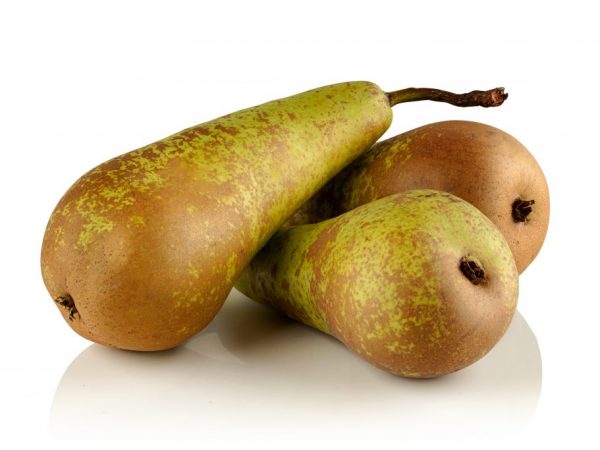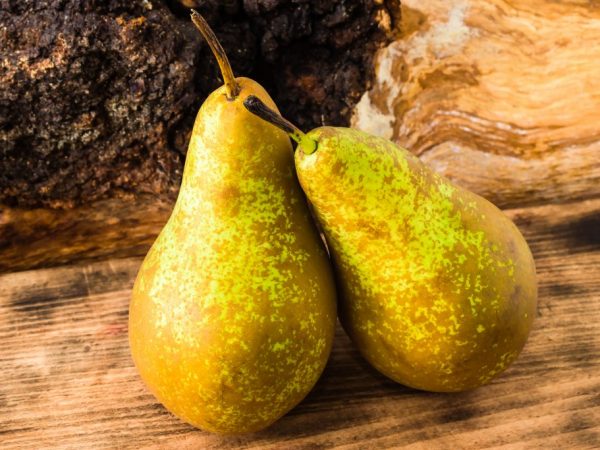Characteristics of the Conference pear variety
Pear Conference is a classic variety of English origin, which has been successfully cultivated in many regions of Russia and other countries for over 100 years. In China, the variety is grown for industrial purposes. It gained its popularity due to its tasty fruits with a dense structure and versatility of use.

Characteristics of the Conference pear variety
It is a mid-season variety with a long shelf life and the ability to finally ripen after being removed from the tree. Undemanding to care and growing conditions.
Characteristics of the variety
An autumn mid-season variety with regular and high yields. An adult tree over 7 years old can produce 35 kg of fruit. The fruiting period begins quickly, the first fruits on young trees are tied 3-5 years after planting. Technically ripe fruits are removed from the tree at the end of September. Pear Conference does not require additional pollinators. But growing in the vicinity of Berre, Williams increases the yield and flavor of the conference pears. Itself can act as a good pollinator of other varietal pears (Striyskaya, Hoverla). It has good resistance to scab and fire blight, but can be affected by fungal diseases.
Among the disadvantages of the Conference pear varieties are the tendency to freeze at temperatures below -18 C. For this reason, the Conference is better suited for regions with mild winters. But many gardeners grow this variety in regions where the temperature drops to -20 and below.
Description of the tree
The description of the plant shows that the trees are vigorous, reaching a height of 5-7 meters. The height may depend on which rootstock the seedlings are grafted on. If quince is used as a stock, then trees grow up to 5 m, on a wild pear stock - up to 8 m.
The crown has a conical shape with a diameter of about 4 m. It is characterized by rapid growth, in one year the branches grow by more than 0.5 m. The leaves are dark green, oval elongated. Blooms in May with white five-petal flowers. The Conference can fully grow and bear fruit for 45-50 years.
Description of the fetus
Fruit weight - 130-160 gr, larger ones 200-220 gr. (in the first years of fruiting). The harvested fruits take additional time to ripen. When fully ripe, they have a pleasant oily structure, no graininess is felt, the taste is sweet with a slight sourness.
Characteristic features of the fetus:
- the skin is green with small brown-rusty spots;
- elongated bottle shape;
- the flesh is from cream to light pink, dense, homogeneous;
- the peduncle is short, arcuate.
The fruits are well stored in the cellar and in the refrigerator, do not lose their juiciness and taste. Shelf life is 4-6 months at a temperature of 3-7 C.
Pears are appreciated Conference in confectionery, after heat treatment they retain their beautiful shape, dense structure, distinct taste and aroma.Perfect for desserts, pies and cake decoration.
The qualities of the fruits of the variety

Delicious and healthy pear
Conference pears are rich in nutrients and vitamins that benefit the human body. Contains glucose, fructose and sucrose. And also vitamins such as A, B1, B2, E, P, PP, C. The fruits contain carotene, folic acid, mineral salts and a large amount of fiber.
Benefit
This sweet fruit can be consumed by people who have been diagnosed with diabetes mellitus or have problems in the thyroid gland, it contains a large amount of glucose, which does not require insulin to be absorbed. Has a pear and immunostimulating, disinfecting and anti-inflammatory properties, and organic acids and fiber improve digestion, stimulate metabolism, this is also useful for children. It will also compensate for the deficiency of folic acid and iron. Pears have a low calorie content (42 kcal per 100 grams) and therefore are used in the dietary menu for weight regulation.
Harm
The description of the properties of the variety says that if the pear is misused, the Conference can harm those who have serious problems with the digestive tract, acute inflammatory processes, peptic ulcer in an aggravated form. Nutritionists and doctors do not recommend eating large amounts of fruit on an empty stomach or after eating meat and dairy products.
Landing features
Autumn is the best time to plant pears in the garden. In order for the seedlings to take root well, they must be planted in September-October. With late planting, young trees may not have time to take root in a new place, and then the chances of freezing in the winter and subsequent death increase.
To grow a good and fruitful conference pear tree, you need to choose a quality seedling and plant it correctly. When buying a seedling, you need to pay attention to the following characteristics:
- It is best to choose an age of 2 years, it will take root easily and grow quickly.
- The rootstock, a grafted pear on a quince, begins to bear fruit faster.
- The root system should be well developed, fibrous without damage.
- The general condition: the seedling should look healthy, without cracks, traces of fungal diseases, damage by pests.
And also on the seedlings there must be a tag indicating the variety and manufacturer. Having chosen a seedling, it must be planted in the ground in the near future.
Site selection and preparation of the landing pit

We spill the seedling well
For the pear to grow and develop well, the planting site must meet certain requirements. It should be well lit and protected from strong winds and drafts. The southern or eastern part of the site is suitable for the Conference. Groundwater on the site should be at a depth of at least 3-3.5 m. Pears grow poorly on heavy and waterlogged soils. And also it should be borne in mind that the Conference pear, in accordance with the description of the variety, is a large tree that requires a lot of space.
It is also necessary to properly prepare the planting pit. In order for the seedling to easily take root, they dig a hole 1 m wide and 0.5-0.6 m deep, but if the root system is larger, then the depth must be increased (up to 1 m). Gardeners recommend filling the pit with 2-3 buckets of a mixture consisting of compost, peat, river sand. This will improve the quality of the soil, provide the seedling with an initial supply of nutrients, and a good structure and looseness will speed up rooting. The bottom of the planting pit should be well loosened so that the oxygen supply process is more intense. When preparing the pit, you need to drive in a support to which the seedling is fixed so that it grows even, and the trunk does not bend when strong winds arise.
Landing
Before planting a seedling, it is placed in a container of water for 12-24 hours. For better engraftment, you can use root formation stimulants (Epin, Kornevin).After that, the roots are coated with a nutrient mixture. To prepare it, mix ½ a bucket of earth with 2 tbsp. ash and add water to the rim of the bucket.
The seedling prepared in this way is planted in a prepared hole, during the planting process, make sure that the root collar remains at the surface level. Gradually, they completely fall asleep with earth, compact the trunk circle and water them with water, 2 buckets of water are used for one tree. If shrinkage occurs after watering, add more earth. The barrel is attached to the installed support. And the seedling is mulched with peat, sawdust or compost.
In order for the seedlings to take root well and quickly after planting during the first month, you need to water the plant 2 times a week, 1 bucket per tree.
Care of young seedlings
In order for young seedlings to grow intensively and turn into strong fruit-bearing trees, they need some care. It consists in the regular:
- watering;
- loosening;
- mulching;
- top dressing.
Watering
Pears are resistant to drought, but during the growth of seedlings, the first 3-4 goals after planting watering is required and should be regular. Pears are watered once every two weeks, 1-2 buckets of water are enough for one seedling. During periods of drought and high temperatures, the frequency of watering is increased to 1 time per week. In rainy weather, there is no need to water the trees. Mature fruit trees are watered 4-5 times per season.
Loosening
It is very important to loosen and weed the trunk circle, loosening is carried out every two weeks to a depth of 10-15 cm. This procedure is carried out after watering or rain. Loosening improves soil structure and gas exchange. Weeding is done as the trunk circle is overgrown.
Mulching
In early spring and late autumn, it is recommended to mulch the trunk circle with peat, compost, and vegetable peels. The soil is watered, loosened, and then the mulch is spread in a layer of 2-3 cm, this will save the roots from a drop in temperature and freezing in winter, and will also serve as a good feeding of prolonged action.
Top dressing
Young seedlings for the first 3 years are enough to feed twice a season, in spring and autumn. You can fertilize the seedlings with organic matter; for this, the dumped manure is suitable. For young trees, slurry is prepared, for this, 0.5 liters of manure is poured with 10 liters of water and left to infuse for 5-7 days. Before use, dilute in a ratio of 1:10 and watered the near-stem circle. And they also use ready-made complex fertilizers for fruit. They are used in accordance with the instructions.
Conclusion
Pear Conference is a variety that is not demanding to care for, has good characteristics and has long been tested by many gardeners. Early entry into fruiting, a stable harvest of sweet and tasty fruits - these are the qualities that brought the Conference well-deserved popularity in many countries.


